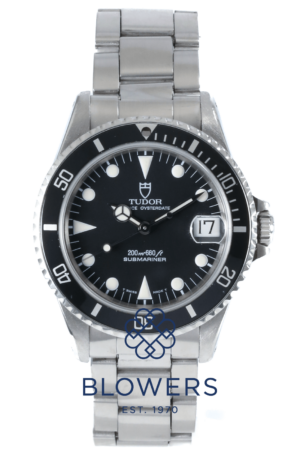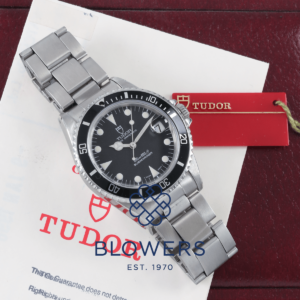Tudor Submariner Watches
One of the most influential timepieces in the entire catalogue, Tudor Submariner watches have had a major impact on the company’s profile. Given their vintage nature, these iconic wristwatches are highly coveted by investors and watch enthusiasts alike, with even more modern iterations being extremely sought-after.
The History of Tudor Submariner Watches
One of the brand’s very first forays into the world of diving timepieces, Tudor Submariner watches were initially released in 1954 with the Reference 7922. Like the Rolex Submariner, which was released earlier, the Tudor version had a screw-down crown and case back, large bright indices and hands, plus a rotating bezel to keep an eye on dive times. The main difference was that Tudor’s specimen was powered by the Fleurier 390 movement. A year later, Tudor brought out the Reference 7923, the first and only Tudor Submariner to feature a manual winding movement. This limited-edition boasted a baton hand and lollipop second hand to further differentiate itself away from Rolex’s models.
The first generation of Tudor Submariner watches continued in 1958 with the introduction of the Reference 7924, more commonly known as the “Big Crown” because of its 8mm crown. This enlarged crown gave the timepiece a better feel and made it much easier to operate underwater. In 1960, Tudor launched the final first generation Submariner, the Reference 7928. The model was intended to be the blueprint for all future versions of the wristwatch and marked a transition from a dress watch to high-quality sports watch, and also featured the very first crown protector for the series. Throughout its production period, the crown protector would become even more rounded, going from square shaped, to pointed and then finally to round.
Tudor Submariner watches entered the second generation in 1969. These new timepieces ushered in the famous “Snowflake” hands and changed the round indices to square markets. Two iterations of this generation were released, the Reference 7021 with a date indicator and the Reference 7016 without a date. Tudor also released smaller case sizes in the 1970s, which became known as “Midsize Subs” or “Mini Subs”. The year 1975 also saw the release of the References 9401 and 9411, which collectors consider to be the traditional Tudor Submariner watches.
The year 1995 saw the release of the final Tudor Submariner, with Reference 79190. Here, the focus was clearly refinement, with its sapphire glass that made it much more scratch resistant. The case was also cut sportively and the bezel was constructed out of stainless steel.
The Instrument for the Professionals
There is no better way of demonstrating the quality of an item than if it is adopted by organisations that represent your target demographic. This is definitely the case with Tudor Submariner watches, which have been held to extremely high regard by the Marine Nationale Française (MN) and the US Navy – alongside many other military organisations across the world. These important entities have equipped their most elite personnel with these timepieces, further enhancing their reputation for robustness and reliability.
Perhaps the most impressive element of this is the fact that the Tudor Submariner watches delivered to these organisations were neither specially-developed nor custom designed for them. Instead, these were just normal models listed in the generic catalogue. The only specialist requirement was that an engraving was put on the case back, for example the French Navy versions were inscribed by the initials MN and the last two digits of the year in which they were delivered.
A Watch in High Demand
Given the fact that Tudor Submariner watches stopped being produced in 1999, almost all of these iconic timepieces are of vintage status. As you would expect, models that are in mint condition are extremely rare and in extremely high demand. This is also the case for first-generation models from the 1950s and 1960s. In fact, a version with the Reference number 7923 and manual-winding calibre 1182 managed to sell in an online auction for $99,999 USD, making it one of the most expensive Tudor timepieces of all time.
Also in extremely high-demand with collectors are the military pieces that were used by the US and French navies. In addition, the second generation of watches produced between 1969 and 1989 are very sought after, with some of the more interesting reference numbers being 7016, 7021, 9401, 9411, and 76100. Even the most recent generation from 1989 onwards are seeing their value rise, despite the fact there are still so many in circulation. As the Tudor brand continues to skyrocket, this is something that is expected to continue.


